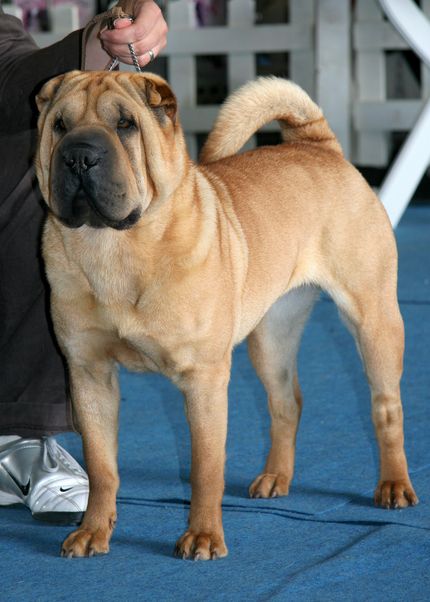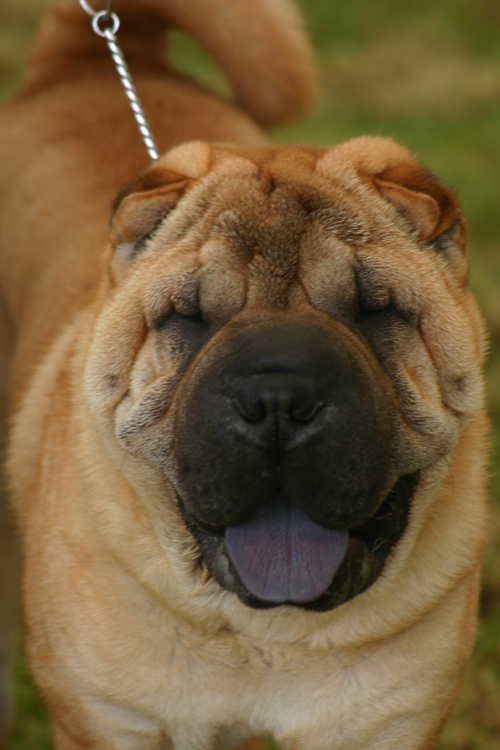FCI – STANDARD
SHAR-PEI
FCI-Standard N° 309 / 09. 08. 1999 / GB
ORIGIN : China.
UTILIZATION : Hunting- and watch-dog.
CLASSIFICATION F.C.I. : Group 2 Pinscher and Schnauzer, Molossians and Swiss Mountain-and Cattledogs.
BRIEF HISTORICAL SUMMARY : This Chinese breed has existed for hundreds of years in the provinces bordering the South China Sea. The town of Dialak in the province of Kwun Tung is probably the place of origin.
GENERAL APPEARANCE : Active, compact, short coupled and squarely built dog of medium size. Wrinkles over skull and withers, small ears and « hippopotamus » muzzle impart to the Shar Pei a unique look. Dogs larger and more powerful than bitches.
IMPORTANT PROPORTIONS : The height of the Shar Pei from withers to ground is approximately equal to the length of the body, from point of shoulder to point of buttock, especially in males. The length from nose to stop is approximately equal to the length from stop to occiput.
BEHAVIOUR / TEMPERAMENT : Calm, independent, loyal, affectionate to his family.
HEAD
Rather large in proportion to body. Wrinkles on forehead and cheeks continuing to form dewlap.
CRANIAL REGION :
Skull : Flat, broad.
Stop : Moderate.
FACIAL REGION :
Nose : Large and wide, preferably black, but any colour conforming to general coat colour permissible. Wide opened nostrils.
Muzzle : A distinctive feature of the breed. Broad from root to tip of nose with no suggestion of tapering. Lips and top of muzzle well padded. Bulge at the base of the nose permissible.
Mouth : Tongue, roof of mouth, gums and flews : bluish black is preferred. Pink spotted tongue permissible. Solid pink tongue highly undesirable. In dilute-coloured dogs the tongue is solid lavender.
Jaws/Teeth : Jaws strong with a perfect scissor bite, i.e. the upper teeth closely overlapping the lower teeth and set square to the jaws. Padding of lower lip should not be so excessive as to interfere with the bite.
Eyes : Dark, almond-shaped with a scowling expression. Lighter colour permissible in dilute-coloured dogs. Function of eyeball or lid in no way disturbed by surrounding skin, folds or hair. Any sign of irritation of eyeball, conjunctiva or eyelids highly undesirable. Free from entropion.
Ears : Very small, rather thick, equilaterally triangular in shape, slightly rounded at tip and set high on the skull with tips pointing towards eyes; set well forward over eyes, wide apart and close to skull. Pricked ears highly undesirable.
NECK : Medium length, strong, set well on shoulders. The loose skin under the neck should not be excessive.
BODY : Folds of skin on body in mature dogs highly undesirable except on withers and base of tail, which show moderate wrinkling.
Topline : Dips slightly behind withers; then it rises slightly over loin.
Back : Short, strong.
Loin : Short, broad, slightly arched.
Croup : Rather flat.
Chest : Broad and deep, brisket reaching the elbow.
Underline : Rises slightly under the loin.
TAIL : Thick and round at the root, tapering to a fine point. The tail is set very high, a characteristic feature of the breed. May be carried high and curved, carried in tight curl or curved over or to either side of the back. Lack of or incomplete tail highly undesirable.
LIMBS
FOREQUARTERS : Forelegs straight, moderate length, good bone. The skin on forelegs shows no wrinkle.
Shoulders : Muscular, well laid and sloping.
Metacarpus (Pastern) : Slightly sloping, strong and flexible.
HINDQUARTERS : Muscular, strong, moderately angulated, perpendicular to the ground and parallel to each other when viewed from the rear. Wrinkles on upper thighs, lower thighs, rear pasterns as well as the thickening of the skin on hocks undesirable.
Hocks : Well let down.
FEET : Moderate size, compact, not splayed. Toes well knuckled. Hindfeet free from dewclaws.
GAIT / MOVEMENT : The preferred gait is trot. The gait is free, balanced, active with good forward reach and strong drive from the hindquarters. The feet tend to converge to a center line when the speed increases. Stilted gait undesirable.
COAT
HAIR : A distinctive feature of the breed : short, harsh and bristly. The coat is straight and offstanding on the body, but generally flatter on the limbs. No undercoat. The coat may vary in length from 1 cm to 2,5 cm. Never trimmed.
COLOUR : All solid colours acceptable except white. Tail and rear part of thighs frequently of a lighter colour. Darker shading down the back and on the ears permissible.
SIZE :
Height : 44 – 51 cm at withers (17,5 – 20 ins).
FAULTS : Any departure from the foregoing points should be considered a fault and the seriousness with which the fault should be regarded should be in exact proportion to its degree and its effect upon the health and welfare of the dog.
SERIOUS FAULTS :
- Deviation from a scissor bite (as a transitory measure, a very slightly overshot mouth is permissible).
- Snipy muzzle.
- Spotted tongue (except pink spotted tongue).
- Large ears.
- Low set tail.
- Coat longer than 2,5 cm.
ELIMINATING FAULTS :
- Aggresive or overly shy.
- Flat foreface with badly overshot bite; undershot bite.
- Solid pink tongue.
- Lower lip rolled in, interfering with the bite.
- Round, bulging eye. Entropion, ectropion.
- Skin, folds or hair disturbing the normal function of the eye.
- Pricked ears.
- Absence of tail; stumpy tail.
- Heavy folds of skin on body (except withers and base of tail) and limbs.
- Not a solid colour (albino, brindle, patches, spots, black and tan, saddled pattern).
Any dog clearly showing physical or behavioural abnormalities shall be disqualified.
N.B. : Male animals should have two apparently normal testicles fully descended into the scrotum.
REMARK : Any artificial physical alteration to the Shar Pei (in particular lips and eyelids) eliminates the dog from competition.
STANDARD di RAZZA
SHAR-PEI
TRAD. ITALIANA
ORIGINE: Cina
UTILIZZO: cane da caccia e da guardia.
CLASSIFICAZIONE FCI
Gruppo 2 : cani di tipo Pincher e Schnauzer, Molossoidi e cani da montagna e bovari svizzeri.
Sezione 2.1 : Molossoidi, tipo Dogue.
Senza prova di lavoro
CENNI STORICI: questa razza cinese è conosciuta da molti secoli nelle province situate lungo il litorale sud del mare della Cina; è probabilmente originaria della città di Dialak, provincia di Kwun Tung.
ASPETTO GENERALE: Cane di taglia media, attivo, compatto, con lombi corti, iscrivibile in un quadrato. Le rughe sul cranio, le pieghe a livello del garrese, le sue piccolo orecchie e il muso, che ricorda quello dell’ippopotamo, gli conferiscono un aspetto unico. I maschi sono più grandi e possenti delle femmine.
PROPORZIONI IMPORTANTI: l’altezza dal garrese al suolo è circa uguale alla lunghezza del corpo dalla punta della spalla alla punta della natica, specialmente nei maschi. La distanza del tartufo dallo stop corrisponde a quella dello stop dall’occipite.
COMPORTAMENTO/ CARATTERE: Calmo, indipendente, fedele, affettuoso verso i membri della famiglia.
TESTA
Piuttosto grande in rapporto al corpo. Le rughe sulla fronte e sulle guance si prolungano per formare i fanoni.
Regione craniale
Cranio: piatto, largo.
Stop: medio.
Regione facciale
Tartufo: grande e largo, di preferenza nero, ma qualsiasi colore in accordo a quello del manto è accettato. Narici leggermente aperte.
Muso:Costituisce un tratto caratteristico della razza. Largo già dalla nascita fino all’estremità, non ha alcuna tendenza a assottigliarsi. Labbra e parte in inferiore del muso molto spesse. Tollerato un rigonfiamento alla base del tartufo.
Gola: la lingua, il palato, le gengive e labbra sono di preferenza nero bluastro. La lingua macchiata di rosa è tollerata; la lingua interamente rosa è tuttavia indesiderabile. Nei maschi di colore diluito, la lingua è completamente di color lavanda.
Mascelle/denti: mascelle forti che presentano una articolazione a perfetta forbice, cioè gli incisivi superiori ricoprono gli inferiori e sono a stretto contatto con essi, impiantati a squadra rispetto alle mascelle. Lo spessore del labbro inferiore non deve essere tale da interferire con la funzione delle mascelle.
Occhi: scuri, a forma di mandorla, con espressione accigliata. Iride di un colore più chiaro tollerata nei cani a manto di colore diluito. La funzione del globo oculare e delle palpebre non deve in alcun modo essere disturbata dalla pelle, i peli o le pliche che li circondano. Qualsiasi segno di infiammazione del globo oculare, della congiuntiva o delle palpebre è da prescrivere. Non accettato entropion.
Orecchie: piccole, piuttosto spesse, a forma di triangolo equilatero, leggermente arrotondate all’estremità; attaccate alte con l’estremità ripiegata nella direzione dell’occhio. Ben piazzate in avanti al di sotto degli occhi, ben spaziate e cadenti ben applicate contro il cranio. L’orecchio dritto è un grave difetto.
COLLO: forte, di lunghezza media, ben attaccato alle spalle. La pelle lassa sotto il collo non deve essere eccessivamente sviluppata.
CORPO: nei cani adulti, le pliche cutanee sul corpo sono assolutamente indesiderabili eccettuato che sul garrese e nella parte inferiore della coda, dove vi sono pliche di media importanza.
Linea superiore: si abbassa leggermente dietro al garrese, per rialzarsi leggermente sul rene.
Dorso:Corto, solido.
Regione lombare:Corta, larga, leggermente rialzata.
Groppa: piuttosto piatta.
Petto: largo e ben disceso, raggiunge il livello dei gomiti.
Linea inferiore: in leggera risalita verso il fianco.
CODA: spessa e rotonda alla attaccatura, si appuntisce in fondo. Coda attaccata molto alta, tratto caratteristico della razza. Può essere portata alta e incurvata, arrotolata a ricciolo, ripiegata al di sotto o su uno dei due lati del dorso. L’assenza di coda o una coda corta sono da proscrivere.
ARTI
ARTI ANTERIORI: gli arti anteriori sono dritti, i lunghezza moderata e di buona ossatura. Pelle senza pieghe.
Spalle: muscolose, ben attaccate, oblique.
Metacarpi: leggermente inclinati, forti e morbidi.
ARTI POSTERIORI: muscolosi, solidi, moderatamente angolati, in appiombo rispetto al suolo; visti da dietro i posteriori sono paralleli. Non desiderabili pieghe sulla coscia, la gamba e il metatarso così come un ispessimento della pelle a livello del garretto.
Garretto: ben disceso.
Piedi: di grandezza moderata, compatti, non appiattiti.
ANDATURE: l’ andatura preferita è il trotto. Il movimento è sciolto, equilibrato ed energico con una buona estensione degli anteriori e una forte spinta dei posteriori. I piedi hanno tendenza convergere verso l’asse centrale quando la velocità aumenta. L’andatura rialzata è un difetto.
MANTO
Pelo: è una caratteristica della razza: corto, duro, eretto. Il pelo è dritto e allargato sul corpo, in generale più coricato sugli arti. Non c’è sottopelo. La lunghezza del pelo può variare e da 1 a 2, 5 centimetri. Non è mai ripulito.
Colore: sono accettati tutti i colori uniti tranne il bianco. Spesso il pelo della coda e della regione posteriori delle cosce è di una tonalità più chiara: un tono più scuro lungo il dorso e sulle orecchie è tollerato.
TAGLIA: altezza al garrese: da 44 a 51 centimetri
DIFETTI
Ogni scarto da quanto sopra deve essere considerato un difetto da penalizzare in funzione della sua gravità
DIFETTI GRAVI
Articolato diverso da quello a forbice ( in maniera transitoria, è tollerato un leggero prognatismo).
Muso a fischietto.
Lingua macchiata ( tranne la lingua a macchia rosa).
Orecchie grandi.
Coda attaccata bassa.
Pelo di lunghezza superiore a 2, 5 centimetri.
DIFETTI ELIMINATORI
Muso piatto con prognatismo superiore importante; prognatismo inferiore.
Lingua completamente rosa.
Labbro inferiore arrotolato che porta all’occlusione delle mascelle.
Occhi rotondi, sporgenti; entropion, entropion.
Pieghe della pelle o peli che interferiscono con la funzione normale degli occhi.
Anuria; coda a moncherino.
Pieghe importanti della pelle sul corpo ( eccettuato il garrese e l’attaccatura della coda) e sugli arti.
Colore non uniforme ( albinismo, rosso a strisce scure, macchie di colore, cani neri focati, macchie a forma di sella).
N.B. I maschi devono avere i testicoli di aspetto normale completamente discesi nello scroto.




